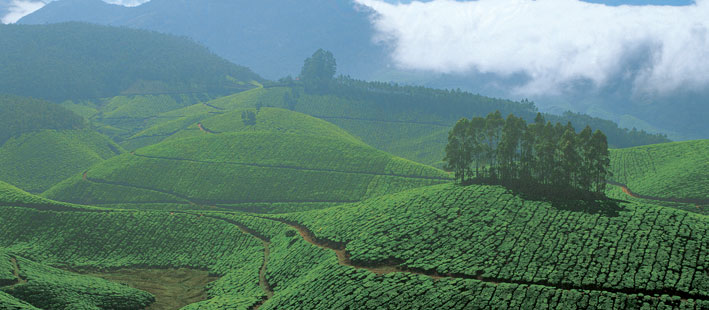
Wayanad
Wayanad is one of the most beautiful districts of Kerala. It’s a boon for those who love forests. I’m always attracted to forests but due to lack of time I never went to Wayanad on my infrequent visits to Kerala. It was thanks to my daughter that I decided on a visit. She had started a village stay in a place called Koleri. The drive from Calicut was really beautiful, through thick rain forests and coconut trees. At one of the stops at a place called Manthavady we had the most delicious coconut drink I’ve ever had. It is made by blending tender coconut flesh with tender coconut water and is surely a drink for the gods.
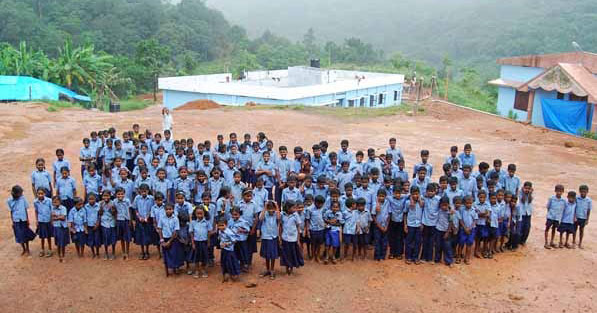
Vivekananda Residential Tribal Vidyalaya at Mattilayam,
Our first stop was at a village called Mattilayam . There is a tribal school there run by two most dedicated and enthusiastic young men called Baburaj and Rajiv. The school compound was most impressive. There were quite a few buildings donated by various people. It’s a residential school housing 250 students, of both sexes. All the children are from the tribal villages around the place. The children are given all facilities for developing both brain and brawn. The Ramakrishna Ashram has donated a small temple for them in which the boys used to sleep at night. Now they are building a separate dormitory for the girls so the boys can get the dormitory which had been reserved for the girls. The school is placed in very beautiful surroundings. Wayanad itself is a most picturesque place. It is a plateau situated at a height between 700 meters and 2100 meters above sea level nestling among the mountains of the Western Ghats, adjoining Tamil Nadu and Karnataka States. Major portion of the state is forest. The school is also on a small plateau overlooking the forests. Running the school is really a most creditable yet very difficult project.
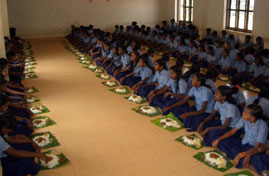
They have to give food three times a day for the children who have healthy young appetites. Even this comes to 8,000Rs. per day. So it’s really a hard battle for them. Just to get teachers for the school is rather difficult since they are not able to give big salaries or other facilities. Their wives are totally supportive and also work at the school.
Our ashram has been supporting them in giving food for some years.
These young men go all over India trying to collect funds for the school. They have approached both state and central governments without much use. Link to Vivekananda Residential Tribal Vidyalaya, at Mattilayam website... Your support is welcome.
It was a real education for us to see the way these young men were working without getting any recognition and very little funds from anyone. God alone supports them. This is actually a teaching to show us that any evolving project into which we throw ourselves heart and soul will always have divine support.
From there we drove to Koileri where my daughter Amala is running a village project www.saveagram.org. Before we reached the village I suddenly spied a small board on which was written, “Tribal steam massage.” I immediately asked the car to stop and jumped out. I was most curious to see what it was all about. The rooms were far from being clean and one woman was lying on a bench waiting for the doctor to come. I felt a bit despondent and quickly backed out and went round to the back of the house and found a young man busy cutting fire wood. I asked him about this and he vaguely pointed in another direction and when I went round, there was a man busy boiling water in a huge cauldron. The scene looked like something from Grimm’s Fairy tales and I wouldn’t have been surprised if he had tipped me into the cauldron so I didn’t dare to venture too close. I asked him about the massage and he shifted his tobacco from one side of his mouth to the other and gave me details. He pointed to small wooden shack at the side and said that I would have to take out my clothes and sandals and go and sit inside. The water was being treated with 81 herbs and the steam was being piped into this shack. I went and inspected the shack before agreeing to take the treatment. The shack was reasonably clean with a wooden floor with gaps in the planks through which the steam came through. I was told to be careful not to put my feet between the cracks. Anyway I told my German friend Sri to keep guard outside and boldly took the plunge. I’m always eager for any new experience especially if it’s natural and tribal and so on.
I must admit it was a delightful experience and I thoroughly enjoyed it. Seeing me coming out with a bright smile, Sri also decided to venture inside since she said she would certainly never get such an experience in Germany.
The culture of Wayanad is mainly tribal oriented. All through our travels we came across many tribal industries and herbs and medicines and medicine men all of which I found most fascinating. Even though the district is considered as being backward, it is one of the biggest foreign exchange earners for Kerala, since most of the major spices, like pepper, cardamom, coffee, tea, are all grown and exported from here.
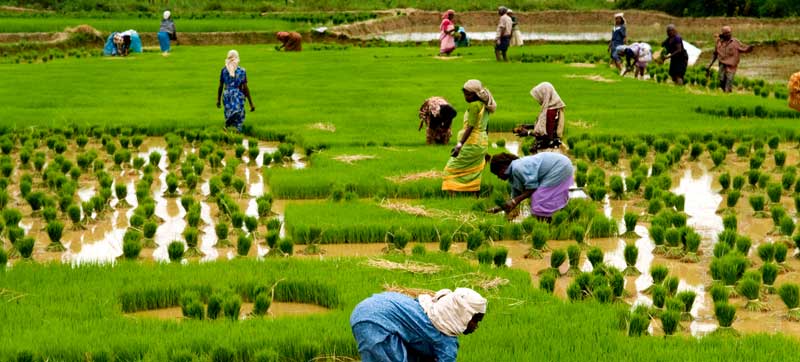
The name Wayanad is derived from Vayal Nadu which means the land of paddy fields. There were an equal number of paddy fields as of forests.
After going through a lot of windy mountain roads we eventually ended up going down a very rough track through which only a jeep could travel. I was struck by the beautiful and exotic types of flowers which grew along the roadside. At last we reached the homestead which was to be our home for the next two days. The farm belonged to Sri Keshavan. His family consisting of his wife, son and daughter-in-law lived with him and they ran the whole show as far as I could make out. It was a lovely house built in typical Kerala style with tiled roofs and a kind of nadumittam or central courtyard.
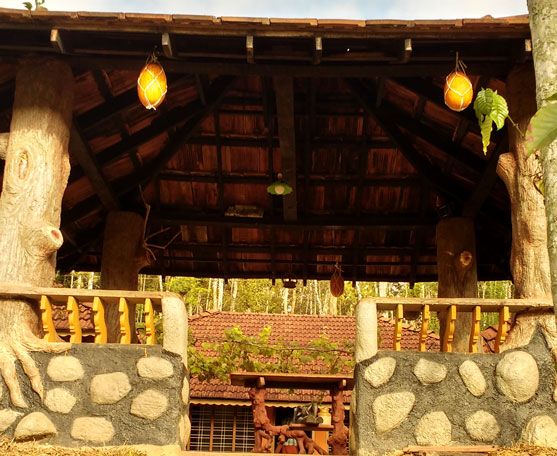
Since Sri Keshavan was a very artistic person he had made a type of pergola with his own hands in front of the open courtyard in which we sat and had lovely tea and nuts etc.
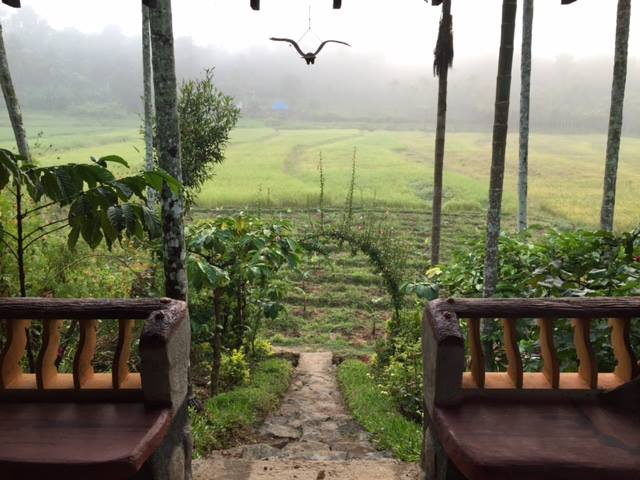
Let me say at the outset that everything we ate and drank at their place including tea and coffee were all grown in their own farm. They had three cows also who looked very happy and well fed who provided milk. They urged us to drink the milk and couldn’t understand when we said that we didn’t like to drink plain milk!!
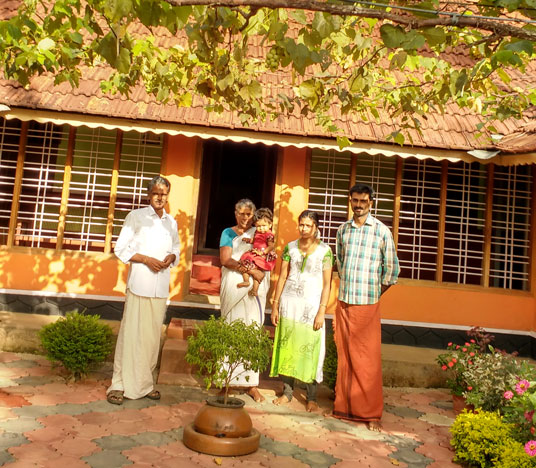
They had three bedrooms for the guests all of which had been very tastefully arranged by my daughter, I’ve no doubt. The bathroom was situated on the other side of the house. This had been done by my daughter complete with European closet, basin, shower etc. The mother would give us steaming buckets of hot water made in a wood fire at the back of the house early in the morning for our baths. It was truly a delightful experience. Breakfast was iddlis, dosas, pittu, appam, idiyappam etc, all of which comprised the typical Kerala breakfast. All these were served with delicious coconut chutneys with different flavours. After breakfast we would set out on our visits to the various temples around the place. In fact the very first evening we went for the arati at a small temple called Velliyur Kavu near the homestead.
Valliyur Kavu
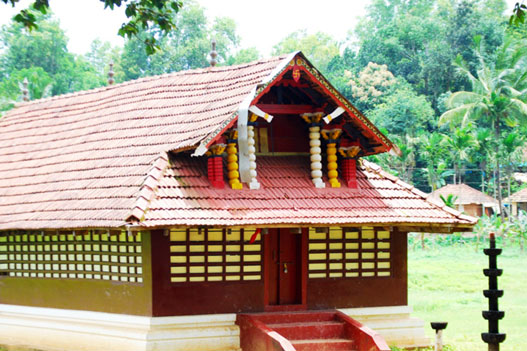
Valliyoorkavu Temple, Mananthavady
Kavu means temple in Malayalam. This was a charming Devi temple. The idol was exquisite. We went at sunset time just before the arati. The temple was surrounded by forest and I was struck by the beauty and peace of the place. We waited for the arati which was truly beautiful. There were no electric lights and the whole place was lit up by the glow from the west and the numerous lamps which had been lit. It was a lovely start to our temple visits. On the way our host stopped at the famous Kabini River which is one of the major rivers in Wayanad and which eventually joins the Kaveri.
That evening we had a delicious dinner of idiyappam which is a type of Kerala noodles made with rice and stew. The stew is made of some vegetables cooked in coconut milk. Almost every dish in Kerala is sure to have coconut- grated, ground or made into milk. The coconut oil which is used for cooking has also got a very special flavour. Of course it may not be palatable to N. Indians but now it has been declared all over the world as being a top grade oil with special health benefits like being good for Alzheimer’s disease.
Early next morning after a delicious breakfast of iddli, sambar and coconut chutney we set out on our temple visits. One of the most famous temples in Wayanad is Thirunelly which is a Vishnu temple. But before going there we are supposed to go to the ancient Shiva temple of Trissillery.
Thrissillery Temple
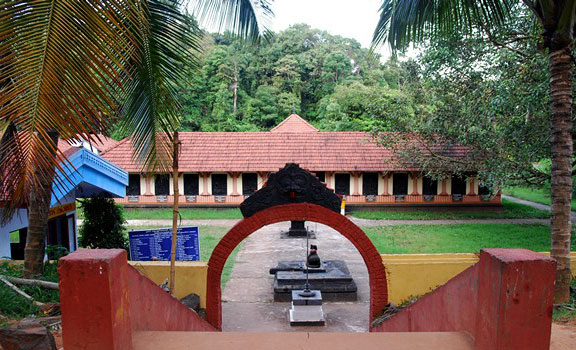
The temple is dedicated to Lord Shiva. It is set in a hollow and one has to climb down some steps to reach the temple compound. The entrance is flanked with an arch with a striking lion’s face.
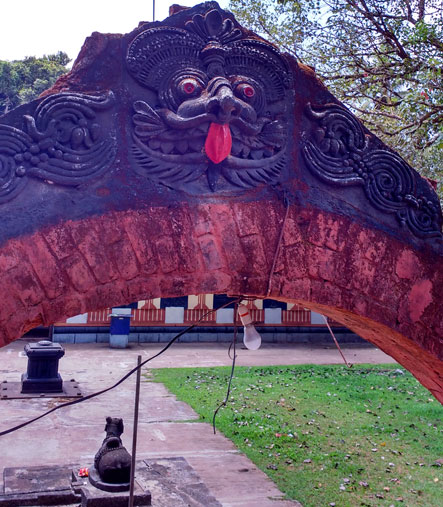
"Kirtimukha" Face Of Glory
If you want to pray at this temple in the correct manner, one has to have a guide. Luckily someone came to our aid as soon as we entered the compound. Actually there are some painted arrows on the ground but these are not so clear and we might not notice them.
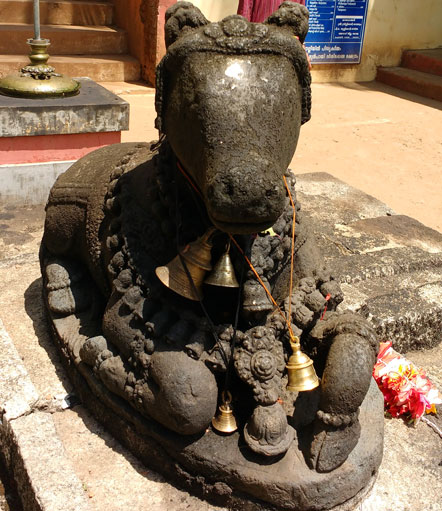
Our guide took us to the small temple tank with crystal clear water which was absolutely untouched by any build ups along the sides. It looked like a sapphire gleaming in the middle of the bushes surrounding it. All types of old fashioned creepers were hanging over it. Apparently the pond never dries even in the severest of droughts. I remember when I was a child to have seen these types of creepers around our own house tank. We were asked to wash our feet in this water before entering the inner parikrama (courtyard).
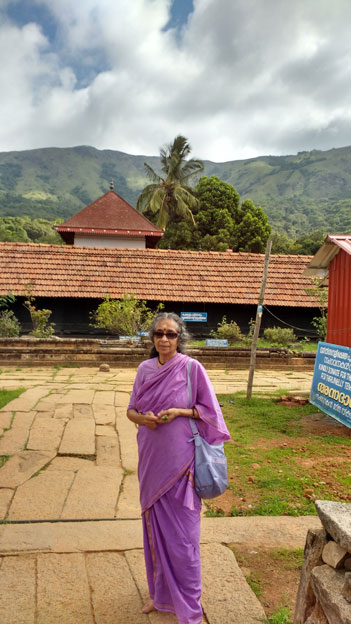
From there we went first to the exquisite temple of Jala Durga, which was surrounded by water. (jala means water) This is a most ancient shrine and is said to have been established by Lord Parashurama, the 6th incarnation of Lord Vishnu. In fact many of the ancient temples of Kerala including Shabarimala are said to have been installed by him. From there we were taken to the Ganesha, Krishna and Ayyappa temples. Now having gone round the peepal tree we had to go round the flag staff (Dwajasthamba) and the inevitable Nandi who is always seen guarding the entrance of every Shiva temple. Only then could we enter the inner parikrama. Even after you enter we had to have darshana of the goddess at the Parvaty Mantapam. Only then could we go near the sanctum sanctorum to have the darshana of Lord Shiva. After praying in front of him, we had to go left until we reached a small channel for the outlet of water which is used for the daily ablutions of the Lord. This is normally in the shape of a cow’s open mouth and is known as the Gomukhi (cow’s face). As is the custom in all Shiva temples we are not allowed to cross this channel which takes the water out. We have to stand there and look up at the Shikara or the carved tip on top of the temple. There is a huge stone just below the Gomukhi which is said to be the Swayambu (self formed), form of the lord.
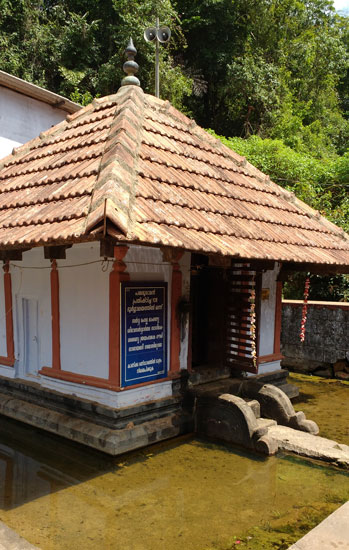
The assistant priest told gave us the esoteric secret that the Lord’s head is here and his feet are in Tirunelli temple ). As we are not allowed to cross the Gomukhi we had to return in an anticlockwise direction and go round the sanctum till we came to the Gomukhi again and look up and pray to the Shikara and return to the main sanctum, pray to the Lord and continue to the Gomukhi and look at the Shikara. Only then can we be said to have completed our worship. These type of rules for praying at the temple is also found in the huge Shiva temple called Vadakkunnathan in the town of Trisshur.
THIRUNELLI TEMPLE
About 30 km from Mananthavady, is a small village situated at the base of the Brahmagiri Hills, which is part of Sahyadri Range on the border of Kerala and Karnataka. The village is a famous pilgrim centre, thanks to the presence of an age-old Vishnu temple (Thirunelli temple) and the nearby stream Papanashini. The proximity to the dense forests makes the place more endearing. The village is also an ornithologists’ and trekkers’ paradise.
From Koileri, the road wound its way through dense forests and elephant sanctuaries. I was even able to take a photo of a wild elephant. There was very little traffic and no sign of human habitation except for stretches of paddy fields. There was a village called Kattikulam from which we had to take a turn to Thirunelli. This place is famous for a shop which is supposed to make the most delicious unni appams, a type of fried, sweet momos which are a delicacy in Kerala. We decided to try them on our way back. The population of Thirunelly actually consists of the tribals or Adivasis which means the original dwellers. I had been to this temple about thirty years ago but of course everything was totally changed. It is in a beautifully located spot, on a small hillock surrounded by forest. It is more than thousand years old.
The temple history goes back to the 10th and 11th centuries and it had been a very important pilgrim center till the 16th century. Apparently archeologists have discovered copper plate inscriptions belonging to the 10th and 11th century. In fact while the new road was being laid they found coins dating back to the 9th and 10th centuries during the reign of the famous King Kulashekhara. The temple is known as the Gaya of the south. Gaya is a pilgrim centre in Bihar which is famous for its rituals for departed souls. Thirunelli is the only temple in India where devotees can perform all the rituals related to one’s life, starting from birth to death and life after death.
So far both the temples we had gone to our German friend, Sri, had been allowed to enter the inner parikrama but our host had already informed us that non-Hindus were not allowed inside. As we climbed up the steps leading to the temple we were met with a spectacular sight. Normally in all Vishnu temples a small figure of the deity is taken round in procession three times a day after the three main pujas- at day break, noon and evening. Just as we came up the stairs the Lord turned the corner of the temple and came straight towards us as if in order to give his devotee a free darshana as it were! I was so thrilled and Sri was too, when I explained the significance to her. She was allowed to explore the surroundings and walk about while we went inside. The idol is that of Vishnu in his four-handed form (chaturbhuja), holding the discus, conch, mace and lotus.
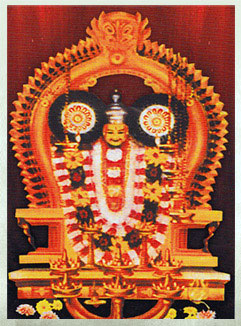
Prathishta
The temple was fairly crowded since it was the special month of Vaishakam which is most auspicious for conducting all types of rituals and for going on pilgrimages since it is the month just before the year turns from Uttarayanam to Dakshinayanam, which denotes the turning of the sun from the north to the south, thus heralding the advent of winter for the northern hemisphere. The same thing happens in January when the sun starts its movement to the north thus proclaiming the advent of Spring to the northern hemisphere. That is known as Uttarayanam. I remembered how isolated it had been on my first visit here more than thirty years ago. I also remembered that as the temple faces east, we had a glorious view of the rising sun at that time.
We came out of the temple after our darshana and went round the temple. I could see the beautiful Brahmagiri range on the north. I was told that the ranges on the other sides were called Karimala with dark green foliage and Narinirangimala which had lighter shades of green.
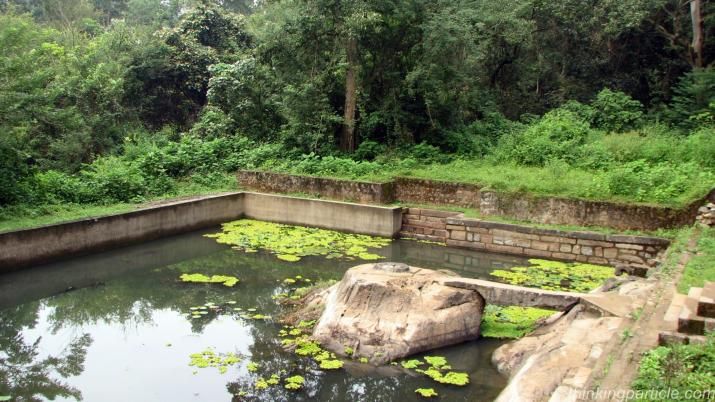
The temple pond is known as Panchatheertham. There is a huge boulder in the middle of the pond called Vishnupada (footprint of the Lord Vishnu). On the right of the temple there is a rough forest track going up to the famous Papanasini. The walk is about 1 km.
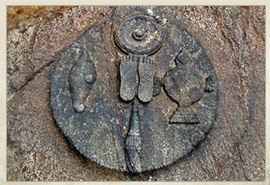
Vishnupada
As I mentioned earlier, rituals done for the departed souls at Thirunelli are said to be very powerful and even the most wicked souls will have peace if their children perform the required rituals at this place. First of all you have to pray in front of the Lord to help the departed soul attain peace. Then the priest accompanies you to Papanasini with materials for the rites. The devotee has to stand in the water of the river and follow the instructions of the priest and offer obeisance to the departed ones. After that you can take a dip in the water and return to the temple for the conclusion of the rites. The word Papanashini means “that which removes all sins”.
Of course as is usual in most ancient temples in India, there are many legends connected with this. It is said that once when the creator Brahma was circling round the earth on his swan he was struck by the beauty of the Brahmagiri hills. He descended and found an idol of Vishnu under an Amla tree. Amla or amalaka is the Indian gooseberry and has many interesting health properties. It is supposed to be the only fruit which contains all the seven rasas or tastes in it. Nelli is the Malayalam name for Amla so the place came to be known as Thiru-nelli, or the holy amalaka fruit. When Brahma installed the idol at that spot he called it Sahyamalaka. Brahma requested Vishnu to bless the place and he did so and said that the waters of that place would have the ability to wash away all sins. Hence the river got the name Papanashini.
Another legend says that Garuda, the eagle vehicle of Lord Vishnu was flying over this place when Brahma was consecrating the idol. Garuda was carrying Amrit or the elixir of life with him and a few drops fell into the stream and thus the river got the power to purify all sins.
The priest told us that it is believed that Lord Brahma comes every morning during the time known as Brahma-muhurtham (3 to 4 am) to worship Lord Vishnu hence the priest leaves a fresh quantity of materials for the puja before closing the temple at night.
Another legend goes that Parasurama, the 6th incarnation of Vishnu came to Thirunelli to perform the last rites for his father, sage Jamadagni. He also took a dip in Papanashini to atone for the sin of having killed so many Kshatriyas.
On the way to Papanashini there is also an ancient Shiva temple with many sculptures. The story goes that once a pilgrim went there and plucked an amla fruit from an amla tree. He left it on the river side to take bath and when he returned to take it, he saw that the fruit had turned into a Shivalinga. Hence it is said that by worshipping at Thirunelly we can have the blessing of all the three major gods of the Hindu Trinity, Brahma, Vishnu and Shiva.
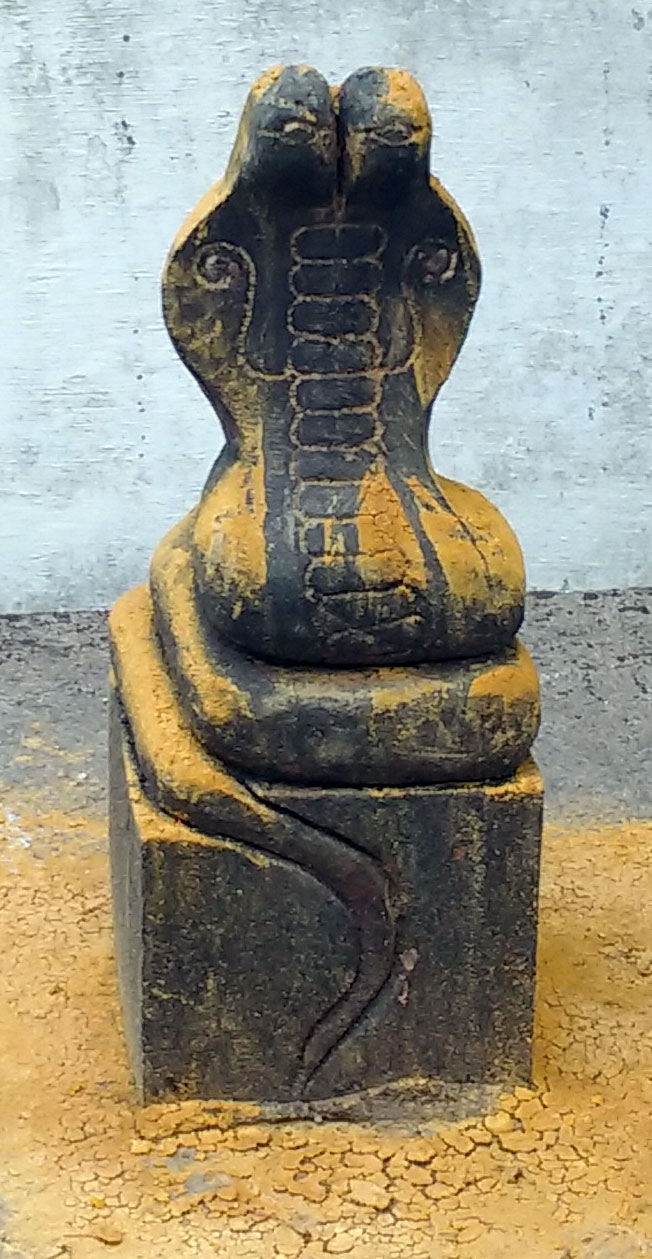
All the way down from Papanashini you can see an aqueduct which carries water from the river to the priest’s room. This is a most interesting feature and of course has another legend attached to it.
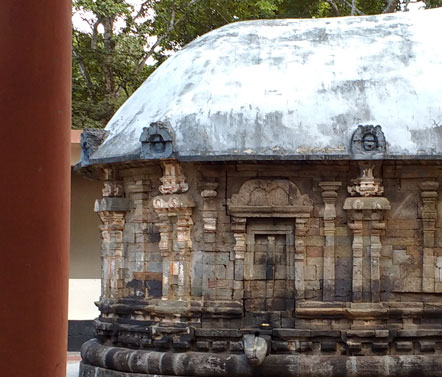
Pulippully temple
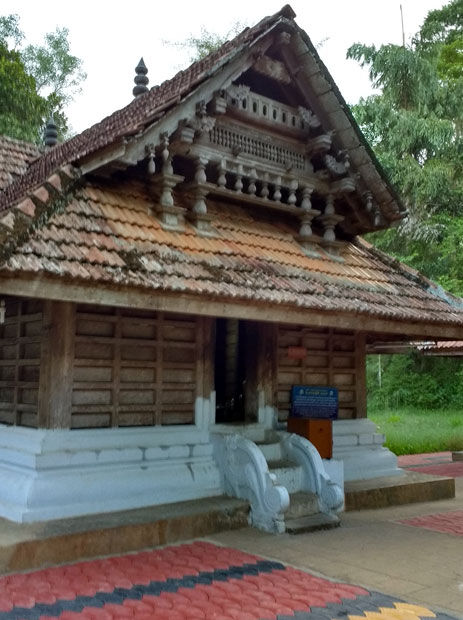
The aqueduct, which ensures a continuous supply of water into the temple from the stream, is believed to have been constructed by a princess from North Malabar (another name for ancient Kerala). When she came to visit the temple she found that there was no water anywhere in the vicinity. Water had to be brought down from the Papanashini river. She immediately ordered the construction of an aqueduct. The original one was a temporary one made with bamboos with the Pulippully temple help of the tribals. Later the princess sent her own masons to construct a proper aqueduct out of granite which is the one we see even now.
There is another interesting tale connected with the unfinished Vilakkumadam, which is a narrow corridor which takes you to the inner courtyard. Apparently it was started by a Coorg chieftain without the consent of the Lord of Kottayam who was in charge of this district. He ordered the work to be stopped. However the Coorg chieftain made use of the remaining materials and finished constructing the Lava/ Kusha temple at Kuthirakode to which we visited later in the day. I felt a sense of great joy after finishing our darshana of the Lord at Thirunelly. On our way back of course we stopped at the shop which made unni-appams and bought some. They were no doubt delicious. I went inside the shack where they were being made and watched the procedure, which is similar to how we make it on our own houses but for the fact that they double fry it in order to make it more crispy. There was a very good tribal shop next to this place which had all sorts of interesting oils and tribal crafts.
On the way back we went to Lava-Kusha temple and the temple dedicated to Sita where she is supposed to have immolated herself into the bowels of the earth. It was a most interesting temple with a lovely little temple of the divine mother. The Lava-Kusha (Sri Rama’s twin sons) temple was in another enclosure attached to a much bigger temple.
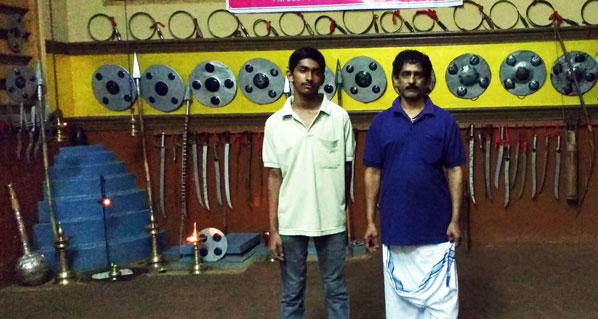
Kalari payattu is the Kerala form of martial arts which is really meant more for self defense than for fighting. That evening we were taken to a Kalari run by a person who was from a family which had been teaching this art from ancient times. A Kalari is normally a circular pit dug out of the ground in which the students are taught. Before the teaching for the day commences the students have to go and pray at the corner in which the guardian deity has been established. I was happy to know that many girls also come to study this art. Since their classes were always in the morning we were not able to see the students in action. But we were fortunate to meet the Master and he was kind enough to show us round the Kalari as well as show us a DVD which had been taken for some occasion. The master is normally a physician as well. He practices what is known as “marma vidya”. This is a form of cure in which the practioner uses both his hands and feet to reach the inner recesses of our body and takes away the pain if there is any. It is very effective in curing all type of orthopedic ailments. Before starting the teaching of the martial art, the student has to undergo a regime in which his whole body will be smeared with oil and the Master will massage him with his feet. This type of massage is of course only used on healthy young bodies which will then become extremely supple and will be able to do the numerous bends and turns and somersaults and jumps which are included in the art.
Many types of weapons which are used in this art were displayed on the walls of the Kalari. The places was lit with flickering lights and I could just picture the turning and twirling bodies gleaming with oil fencing and foiling and jumping and turning. It was quite a fascinating sight. It is said that Kalari payttu as it is known was the forerunner of all the Japanese martial arts like Jujitsu and Karate. . Apparently one of the great masters from Kerala had gone to Japan and taught there.
KOTTIYUR MAHADEVA TEMPLE
(aka Kottiyoor Mahadeva Temple)
Kottiyur Shiva temple is really a misnomer because actually speaking no temple exists or shall I say two temples of the same name exist. One can always be visited but the other “appears” only in the month of Vaishakam. Without knowing anything, only due to His grace it so happened that our little party arrived at that spot at the correct time. Now to give some idea of what I am talking about let me dilate on the legend.
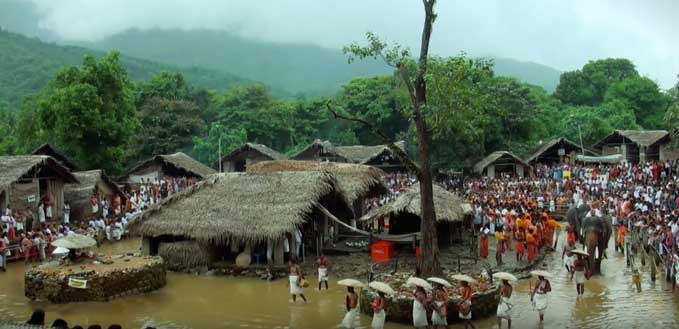
This ancient temple of Shiva is in Kannur district. It is in the valley of the Sahya range. The Bavali River, filled with medicinal waters flows from the Wayanad Ghats and passes near the temple. On the north side of this river there is a small lake known as Thiruvanchira and in the midst of this lake is the temple which has no permanent building of any sort since it’s covered by water most of the time. In the middle of this lake is a small stone which is swayambhu or self born, (not installed by human hands). This is found on a big slab known as Manithara and is the centre of attraction during the month of Vaishakam during which the waters of the lake dry up to ankle deep and thus allow devotees to worship the Lord. In the same lake close to this, is another small linga known as Ammarakallu where Parvati is worshipped. This temple is known as Akkara (opposite bank) Kottiyur and as I said it is open only during the month of Vaishakam. The original temple on the other bank of the river on the main road is known as Ikkare (on this bank) Kottiyur.
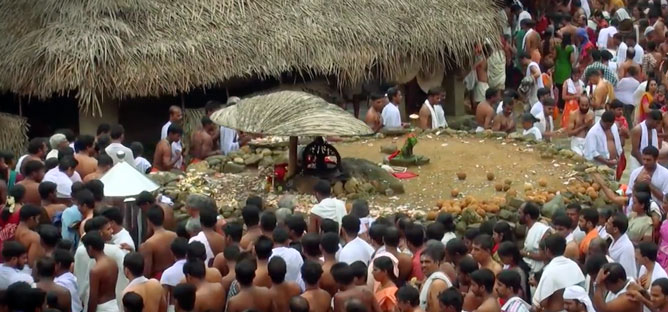
അമ്മാറക്കല്ല് Ammarakallu , where Parvati Devi is worshiped, as Sati
Kottiyur is actually said to be the place of the Daksha Yaga. In the North people believe that Kankhal, near Haridwar is the place of the Daksha Yaga. Daksha was one of the Prajapatis or patriarchs and his daughter Sati had married Lord Shiva. For some reason Daksha felt he had been insulted by his son-in-law and in order to take revenge he started a huge yaga to which he deliberately did not invite Shiva and Sati. However Sati went to her father’s yaga against Shiva’s wish and her father refused to give her a seat or even look at her face. She also noticed that no offering had been made for Shiva. Enraged at this she cursed her father and decided to abandon the body which had come from Daksha. She immolated herself in the fire of austerity. Kottiyur is the place where she is supposed to have done this. Shiva was enraged when he heard this and sent his ferocious general, Veerabhadra along with a host of ganas (Shiva’s entourage) to destroy the yaga. This was ruthlessly done and Daksha’s head was also cut off. Since the yaga had come to an ignominious end, the gods feared that negative effects would soon be felt in the world, so Brahma and Vishnu along with the other gods went to Kailasa to beg Shiva to restore the yaga and complete it. Shiva went with the other gods and restored the yaga. All the other gods returned to their own abodes but Shiva who was bemoaning the loss of his beloved wife, Sati, stayed back in the form of a swayambhu linga next to where Sati had immolated herself. This is the linga which is worshipped here and the Ammarakallu is the place where Sati had immolated herself. Since the trimurtis (trinity) in the form of Brahma, Vishnu and Shiva met in this place it came to be known as Koodiyur. “Koodi” in Malayalam means to meet or join. This later became Kottiyur. One of the famous offerings here is a strange looking thing which is made of the tender stem of the bamboos which grow in abundance here and is supposed to be the beard of Daksha. Actually it does look very much like a gray beard.
This lake is supposed to be the yajna bhoomi or place where the ancient Vedic yajna took place. In fact the original name of the lake was “rudiram chira” or lake of blood. This was later corrupted to form the word Thiru-vanchira. “Thiru” means “auspicious.”
Every year in the month of Vaishakam a twenty-eight day pilgrimage is observed to which thousands of pilgrims come. In fact it is something like the pilgrimage made to Sabarimala in the month of Makaram or the Kumbh Mela in Prayag.
Of course this place has no sreekovil/garbhagriha (sanctum sanctorum). Everything takes place on a raised platform made out of the stones from the river known as the Manithara. Temporary thatched huts are erected every year and removed at the close of the festival and thrown into the lake. The lake has a spring from which water flows towards the Bavali River to the west. The Manithara is located at the center of this lake. The entire shrine actually looks like a Shivalinga itself if viewed from above. There is another raised circular platform beside the main shrine known as Ammarakallu where Sati had immolated herself. In front is the giant, Jayanti vilakku, or lamp and an idol covered by a palmyra leaf umbrella, which used to be popular in Kerala before the advent of the modern umbrellas. All the rites and rituals observed during these 28 days were laid down by Adi Shankaracharya.
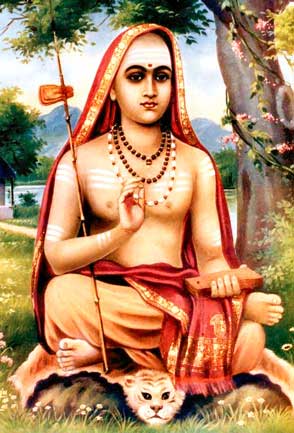
Of course this story took place in Vedic times. During the course of years the forest had completely overgrown the whole place and the only human beings who roamed around were the tribals or Adivasis. A few centuries ago it is said that one of them when he was out hunting, wanted to sharpen his knife. He spied a shining stone on which he started to whet his knife and very soon a fountain of blood spurted out of the stone. He was terrified and ran through the dense jungle to the Namboodiri (Kerala Brahmin) who was supposed to know all about esoteric happenings. The Namboodiri collected the chiefs of five of the prominent Nair families and they ran to the site where blood was still spouting. He immediately asked for milk and ghee to be brought and poured it over the stone but however much he poured the blood would not stop. Just then one of the tribals arrived carrying a bunch of tender coconuts. The Namboodiri immediately asked him to cut a coconut and give it to him. He did abhishekam (ceremonial bath) with this tender coconut water and immediately the bleeding stopped. After that he applied sandal paste etc. Since then the ceremonial washing of the lingam is always done with tender coconut water, milk and ghee.
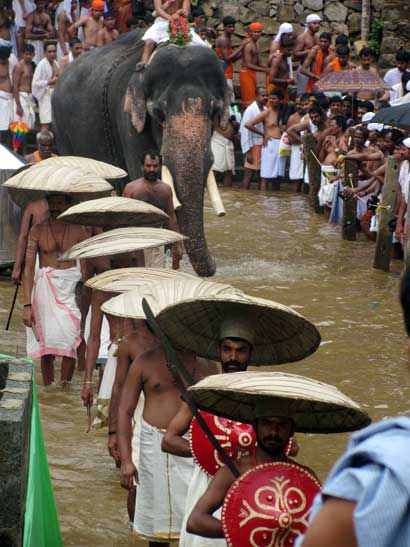
It was our great good fortune that we were able to go to this temple after our tour of Wyanad and thus see all these wonderful sights for ourselves. From the town we had to park the car and cross the Baveli River over a bridge. Actually most pilgrims take a bath in this river before proceeding. A strange thing was pointed out to us about the small stones found in the river. If you rub them on a stone sometimes, you will get some red paste and sometimes white, denoting Shiva and Parvati. Shiva of course is always adorned with white ashes (vibhuti) and Parvati with vermilion (kum-kum). From the river we had to climb a slope. Two caparisoned elephants were taking rest on the side as we climbed up. On top we could survey the lake below with the temporary huts and the make-shift arrangement round the two stones. There was a huge peepul tree under which offerings were being sold. We climbed down to the lake and had to circumambulate the shrine within the pond, with feet sloshing ankle deep in the water. There was a slight drizzle. But very soon a hot sun came up. There was a huge crowd and we were made to queue up on a side. People were coming from the other side also so groups were let in alternately. Everything was very orderly and there was no pushing and shouting. The helpers were many and most helpful! At last we reached the ammarakallu and the Swayambhu lingam but of course there was no time to observe too closely. Even though the helpers did not shout or push as in many temples, yet we were encouraged to take the prasadam and quickly move forward as so many people wanted to take darshana. Actually the people who were with us told us that we were most fortunate since the queue was so short. Normally it would stretch right up to the bridge. It was only Shiva’s grace that we were able to have this amazing experience. Sri is a great Shiva bhakta and I feel its her good fortune that we were able to go there. Aum Namashivaaya
We encourage you to support these worthy charities....
An Unforgettable Experience: SaveAGram
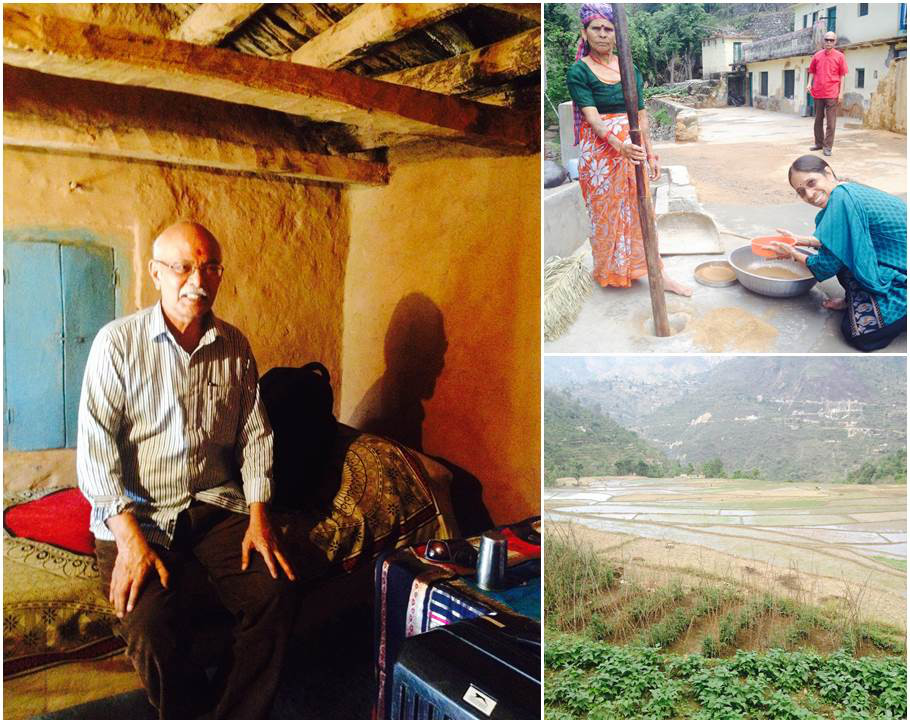
Our SaveAGram experience in Gaja was spectacular. We were welcomed warmly by the local team and villagers not just into their homes, but also into their lives. The view from our mud-walled, wooden roofed, simple, but clean room was lovely- mountains & fields of green as far as the eye could see. We experienced things unheard of in the cities- ate wild raspberries, drank water from natural springs! At the same time, we appreciated modern amenities (e.g. new bathroom) - Lata & Bala, SG, May 2014
Saveagram Village Retreat
Vivekananda Tribal Vidyalaya
Home